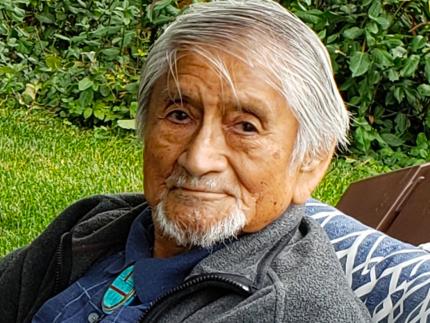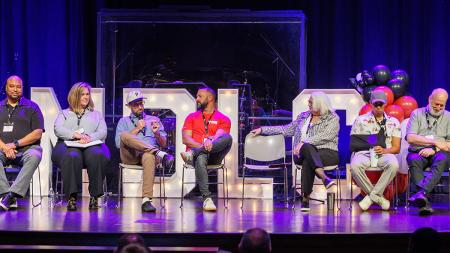Ernie Benally’s Long Walk: In Memoriam

In the 1860s, even as the Union Army of the United States was emancipating African Americans in the south and east, western troops were decimating Native American life and livelihood in the west. The Navajo were the last of the resisters, and in January 1864 in Arizona’s Canyon De Chelly, army troops gathered an estimated 8,500 Navajo men, women, and children, burned their homes, destroyed their crops, and – in the dead of winter – marched them some 300 miles across New Mexico to Fort Sumner. Two hundred of the captives died along the way; two thousand more died during their four years of detainment.
Then, in June 1868, when Navajo leaders finally signed a treaty with the U.S., everyone was simply left to find their own way back home. And one Navajo woman, who was a teenager at the time, told of joining a group of women and girls who had begun wandering west. With no shoes and no food, they never would have made their way back without the kindness of other native people. Navajo people still carry deep hurt over this dark chapter in their history.
Ernie’s Early Years
Three generations later, Ernest (Ernie) Phillip Benally, a great grandson of that teenage Navajo girl, began his own long walk. Ernie was born on Sept. 30, 1935, in a traditional hogan 15 miles northeast of Crownpoint, N.Mex. As Ernie described it, his parents lived a sparse ‘hogan level’ lifestyle, with no formal education or experience with the outside world, raising sheep on the high desert and firmly committed to the traditional Navajo religion and Navajo values. This was Ernie’s life until he was age 10, when his dad enrolled him at the Bureau of Indian Affairs (BIA) boarding school in Crownpoint and told him “to learn from the white man.”
Along with an accelerated elementary education, Ernie was introduced to the white man’s religion. How it came about was typical for that period. BIA schools granted “released time” for churches to give religious instruction. By these means, through Christian Reformed Church missionaries, Ernie learned about Christianity. He was captivated by the Bible stories and other Christian teachings he learned, and, eventually, under the tutelage of a local missionary, Ernie made a profession of faith, was baptized, and felt called to Christian ministry.
Ernie next attended a vocational high school in Phoenix, Ariz., and he studied for an additional year at Rehoboth Mission School. Now pursuing missionary service in earnest, he completed two years at Dordt College (then a two-year school) in Sioux Center, Iowa, and one year at Calvin College (now University) in Grand Rapids, Mich. Then, in January 1960, he married his sweetheart, Martha Begay. For the next two years he worked full-time as a missionary helper and interpreter. Then, after a year of additional schooling at Kuyper College in Grand Rapids, Mich., Ernie was allowed to work more independently as an assistant missionary, though still under the supervision of a white missionary. After serving in that role for one year in Sanostee, Ariz., and two years in Bethlehem near Gallup, N.Mex., Ernie resigned from missionary service.
Good Days, Bad Days
As you might guess, Ernie’s pathway to faith in Jesus and into missionary service was not always a walk in the park.
There were very good days! For example, because Ernie had been hospitalized and couldn’t attend the profession of faith class he had enrolled in, he was invited to live, work, and study with the local missionary that following summer. And he was invited back for two summers after that. Another God-thing: when Ernie ended up in a difficult boarding situation at Dordt College, a classmate convinced his parents to “adopt” Ernie into their Christian home and family for his entire time there.
But there were also very bad days! One particularly painful incident occurred while Ernie was at Calvin College. He had left his duffle bag in the Commons lobby during the dinner hour, and when he returned after dinner, his books and papers were scattered in the lobby and his duffle bag was missing. After a careful search, he found his duffle bag in the restroom wastebasket: someone had defecated on it. To Ernie the message was clear: “We don’t want your kind on our campus.”
Disappointed by the unresponsiveness of college officials, Ernie dropped out, too ashamed to explain the reasons to his people back home but harboring hurt and anger for decades.
Another very bad day occurred while he served as an assistant missionary. The lesser-trained workers had been feeling underappreciated and were poorly paid. After many conversations, the group decided to present their frustrations to the ordained white missionaries. Yet, at the agreed-upon meeting time, some of the workers did not show up and others failed to speak up, leaving Ernie alone to present their case. The only white response was from a veteran missionary who gave Ernie a tongue-lashing for voicing the group’s discontent. On his way home, Ernie wept and decided that he would leave missionary work when another employment opportunity arose.
Another Opportunity
Ernie’s opportunity came in 1968 – for a career in social work, starting with a job with the state of Arizona, and later with the BIA and tribal social services. After scoring high on an entrance exam, Ernie earned a scholarship to study at the University of Utah’s College of Social Work and acquired a master’s degree in 1974. He and his family relocated to Farmington, N.Mex., where he became manager of BIA Social Services for the northern Navajo region.
“Ernie, where are you in your Christian life?”
One day, while he was working as a social worker, Ernie stopped at a Navajo family camp and asked for directions. A woman who lived there was a Christian he knew, so he greeted her and then asked for directions.
“Ernie,” she said, “I’m not giving you any information until you tell me where you are in your Christian life.”
He then recounted the Bible story about the people following Jesus who were offended because Jesus had talked about their eating his body and drinking his blood (John 6). In that story Jesus had asked his disciples, “What about you? Are you going to leave me too?” And Peter had said, “Lord, to whom else would we go; only you have the words of eternal life.” Ernie explained that this was what Jesus meant to him personally.
She said, “Well, now I know where you are in your Christian life, so I will give you directions.”
Throughout those years of change, Ernie and his family remained faithful to the Lord, also participating actively in CRC congregations in Gallup, Crownpoint, Salt Lake City, and – for decades – with the Maranatha CRC in Farmington.
A Surprising Turn
Ernie retired from his social work career in 1996 at age 60. Around that same time, the CRC’s regional director for Classis Red Mesa had resigned. In the process of searching for a person to fill that position, Ernie’s name surfaced. And eventually Ernie was challenged to consider serving in that position. He was led to say “Yes,” and he served in that role for three years.
That was a meaningful time for Ernie, consistent with a renewed sense of call and his love for the church. But it was also a challenging time in his personal life. Three months after he began in the new role, his wife, Martha, was diagnosed with pancreatic cancer, and she died unexpectedly after a surgery. Along with this loss, and facing several personal health issues, Ernie was disappointed when Classis Red Mesa later denied him the opportunity for ordination.
True to character, after stepping down from the Red Mesa director role, Ernie continued to support broader Red Mesa concerns on a volunteer basis, such as the Rehoboth-Red Mesa Foundation and the Red Mesa Leadership Development Network.
More Surprises
Ernie later became a close friend of Ruth Heil, a granddaughter of pioneer missionary L. P. Brink. She was serving as head teacher at the Crownpoint Christian School. Referencing personal health issues, Ernie liked to explain that Ruth agreed to accept him “as is.” They were married in August 1997. A delightful side story is that Ruth’s daughter Susan LaClear was in music ministry training elsewhere, and with Ernie’s advocacy Susan was eventually ordained as a CRC minister for service to Maranatha Fellowship CRC in Farmington.
A more recent surprise was that Ernie and Ruth pulled up stakes in western New Mexico and moved to western Michigan. Ruth’s daughter Susan and her family had recently moved to western Michigan for a new ministry position. And as part of “cleaving” to his new life and love, Ernie agreed to this final stretch in his long walk.
The greatest surprise of all is the amazing grace of God, with his power to transcend the cultural distance between Navajo tradition and the Christian gospel in white clothing.
So it came to pass that on Dec. 5, 2021, Ernie was translated from his temporary home in Hudsonville, Mich., to his eternal home with the Lord.
Ernest Phillip Benally is survived by his daughters Deborah, Diane, Tina, and their families, and by his wife, Ruth, and her children Ed, Steve, Susan, and their families. He was preceded in death by his first wife, Martha, and his son David.
Al Mulder, who wrote this story, is a long-time staff member of Resonate Global Mission and self-published My Walk of Faith by Ernest Philip Benally in 2014, as told to Mulder. Contact Mulder at [email protected].


